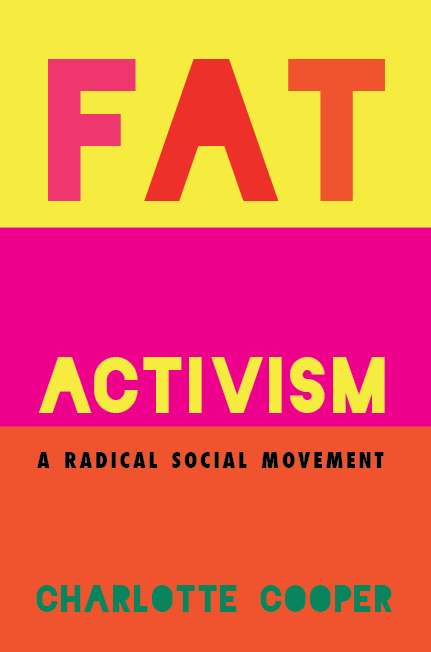Like this article? rabble is reader-supported journalism. Chip in to keep stories like these coming.
After reading Charlotte Cooper’s new book, Fat Activism: A Radical Social Movement, I found it difficult to summarize what fat activism is for readers who may be new to the concept. Cooper intentionally shows fat activism to be multifaceted.
For her, fat activism can range from the Health At Every Size (HAES) movement, to fatshion (a portmanteau of fat and fashion) to the stage persona of Beth Ditto, lead singer of indie rock band Gossip, who is well known for unapologetically strutting her fat naked stuff on stage.
It turns out that fat activism is not reducible to one thing and is susceptible to the internal contradictions and misdirected political intentions of any contemporary activist movement.
Cooper is a prolific writer, activist and cultural worker. Fat Activism originates from her doctoral research at the University of Limerick in Ireland.
Originally asked to study fat discrimination in the dietetic clinic, Cooper intentionally shifted her research to fat activism. This shift allowed her to place fat people at the centre of knowledge about themselves.
Rather than reproducing fat people’s helplessness and marginalization via the power of the non-fat, medical expert, exploring the history of fat activism allowed Cooper to focus on fat feminist perspectives.
As a self-identified fat person and fat activist herself, Cooper’s project originates from the community to which it speaks. It is a rare instance of knowledge production by and for fat people.
Cooper locates the origins of fat activism in 1970s lesbian feminism. This fat activism morphed and travelled across U.S feminist communities created by the women’s movement to spawn fat feminist groups. The movement gained popularity in the 1980s and 1990s and spread to other countries.
Currently, fat activism proliferates across many sites, especially the feminist blogosphere. However, Cooper wants to challenge the implicit cultural imperialism behind this narrative of fat activism as a U.S. export.
Cooper also notes fat activism’s race problem, where the voices and perspectives of fat people of colour are excluded from an activism whose image is predominantly white, middle class and female. The arguable failure of the movement to expand to include anti-colonial, anti-racist and anti-imperialist perspectives has led, Cooper believes, to the stagnation of mainstream fat activism.
The HAES movement is cited as one of the instances of fat activism that does little to challenge the fatphobic status quo.
One of the fat activists Cooper interviews notes that activists drop out of the movement as they inevitably age and become sick, as do most of us. HAES is a medical discourse that still creates a dichotomy of ‘good’ and ‘bad’ fat people; those whose bodies are active, healthy and who eat well are privileged above those whose bodies are not healthy and don’t eat healthy foods. This praise of the ‘good’ fat person can be seen in the recent feminist interest in fat yogis.
In this model, the fat yogi is acceptable as their body can still perform exceptional feats of athleticism. Fat yoga teacher Dianne Bondy’s recent advertisement for the plus size fashion outlet Penningtons, set to a Bollywood-influenced tune, focuses on all the things her fat body can, unexpectedly, do. The flexible fat body is interesting as it is an unusual fat body. This focus on the exceptional fat body does little to undo the hierarchy of good and bad fat bodies.
The Penningtons ad is one example of the way fat positivity has been absorbed by corporate interests. Cooper notes that fat activism is currently enjoying unprecedented visibility, in mainstream as well as feminist media, yet those whose voices are already marginalized are being pushed further out.
Cooper uses the analogy of gentrification to describe what happens when activism has access to dominant power, yet fails to transform it. Counter-cultural expression is adopted by corporate interests and then resold back to the community as a marker of identity. We can see this happening to drastic effect at gay prides in the large cities of Western, developed countries.
In the case of fat activism, fat consumers become another group with capital to explore. Those with buying power are able to access fatshion in the form of expensive plus-size clothing lines, while those without capital are further excluded from this form of fat acceptance. This is also a gendered dynamic that mostly targets women.
Cooper leaves the reader wondering what’s next for fat activism. Although recent media interest in fat positivity has allowed fat activist language to enter the mainstream, it has also refocused the movement on individual consumerism rather than social transformation.
However, the voices of fat activists of colour are starting to challenge the predominance of white voices in fat activism, hopefully leading the movement towards the inclusivity that Cooper desires.
Fat Activism: A Radical Social Movement is the first book to attempt to chronicle the history of fat activism and it meets the challenge well. However, I left the book feeling a little unclear about the timeline of this history. This disorientation may result from an intentional refusal to tell the story of fat activism as one of chronological progression. I look forward to further books about fat activism. Cooper has started a conversation that needs to continue.
Laura Brightwell likes to think of herself as a writer. She is currently a PhD candidate at York University and can be found online at lipstickterrorist.wordpress.com and @mslauralipstick on Twitter



